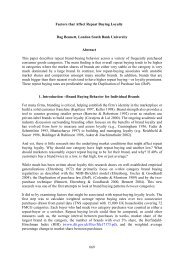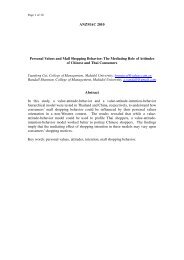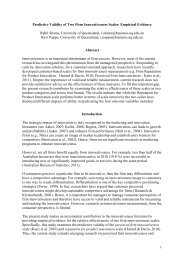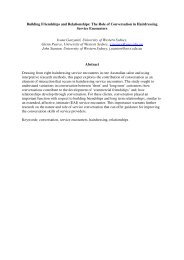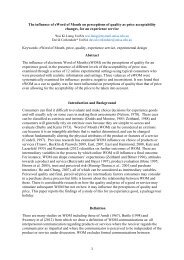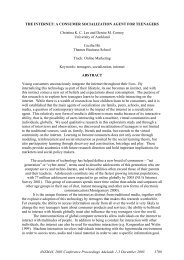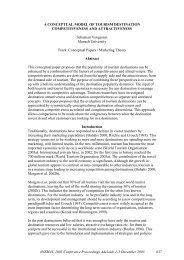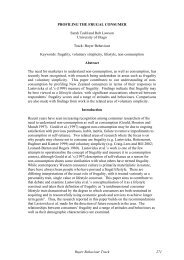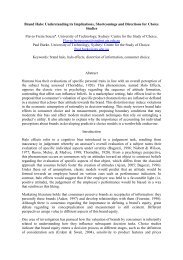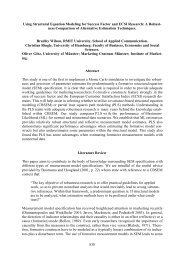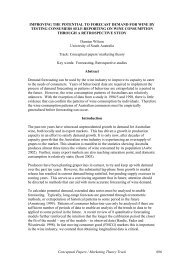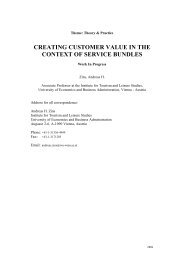amj Australasian Marketing Journal - ANZMAC
amj Australasian Marketing Journal - ANZMAC
amj Australasian Marketing Journal - ANZMAC
You also want an ePaper? Increase the reach of your titles
YUMPU automatically turns print PDFs into web optimized ePapers that Google loves.
much greater than is the case for jeans and pineapple.<br />
However, for other products the effect of price is significant<br />
in relation to purchase intentions and quality perceptions but<br />
it is ranked as the least important of the factors studied.<br />
It is evident from this research that in a multi-cue situation,<br />
the country effect is still important as this study reported that<br />
COA is the most important factor and COD is also significantly<br />
important in purchase intentions for high involvement<br />
products. These results support Johansson and Nebenzahl s<br />
(1986) results in relation to car manufacture. Brand and price,<br />
as other information cues, are important though they are not<br />
as salient as COA. This result is also similar to the findings of<br />
Han and Terpstra (1988) in which they reported that sourcing<br />
country stimuli had a more powerful effect than brand name<br />
on consumer evaluations of bi-nationally produced cars.<br />
Further, it was found that consumers are not biased towards<br />
the products of their home country.<br />
For manufacturing companies, there are some important<br />
implications. Most notably, COA is the most important of the<br />
four cues studied and more important than brand and COD.<br />
Thus, the choice of countries for manufacture will have an<br />
important influence on consumers choice. Secondly, branding<br />
is less important than COA. Thus, shifting production to<br />
less developed countries to take advantage of their lower costs<br />
(while retaining design and brand name) will typically<br />
adversely affect consumers perceptions of quality and, ultimately,<br />
their product choices. Thirdly, price is generally less<br />
important than COA and COD (to a lesser extent) suggesting<br />
that the cost advantage enjoyed by shifting to a less developed<br />
country may not be sufficient incentive to secure the<br />
consumers choice. While the case of cars was the exception,<br />
a price 20% lower was sufficient to alter the consumers<br />
choice criteria. This may suggest a greater reduction in<br />
margin than the manufacturer may be willing to accept.<br />
Collectively, these findings suggest that manufacturers might<br />
need to reconsider their strategies of relocating the production<br />
of their established brands and products to lower-cost countries.<br />
The evidence suggests that consumers don t buy it .<br />
7. Future Research<br />
Although the country of origin field is, by now, extensively<br />
explored in the literature, these results demonstrate that the<br />
field still has important findings yet to be revealed. From a<br />
research perspective, the present study suggests a number of<br />
potentially fruitful research directions.<br />
Firstly, the complex combination of cues in this study<br />
suggests that the simple single cue (ie country of origin) studies,<br />
typical of past research, are no longer sufficient.<br />
However, the use and interpretation of conjoint analysis in<br />
this study, equally implies that all customers will employ<br />
complex compensatory decision rules in their actual<br />
purchases. This, of course, cannot be safely assumed and thus<br />
a future stream of research could examine the interplay of<br />
multi-attribute cues and the array of compensatory and noncompensatory<br />
decision-making regimes.<br />
Secondly, the five cues studied herein (ie product, brand,<br />
price, COA and COD) are, themselves, a simplified abstraction.<br />
Other potentially important cues were, of necessity,<br />
excluded from the present study (largely as a result of the<br />
constraints of the conjoint design). Notable amongst these is<br />
product design which, especially in the case of some<br />
socially conspicuous products such as cars and fashion<br />
clothing, it could be expected would play a very important<br />
role in buyers decision-making. Would buyers trade off<br />
concerns about COA and COD if the product was more attractively<br />
designed? This can only be answered empirically in<br />
future research.<br />
Following this argument, a variable which has recently<br />
assumed prominence in the Australian context is that of<br />
country of ownership . This is a reflection of the perceived<br />
high degree of foreign ownership among the Australian manufacturing<br />
industry. 5 Future research could therefore include<br />
country of ownership as another extrinsic product cue in<br />
countries where the issue of foreign ownership is topical.<br />
Finally, the implications of this research for advertising<br />
campaigns which stress either COD and/or COA need to be<br />
carefully designed to reflect the often complex interaction of<br />
these, and other, marketing mix cues. In such an environment,<br />
careful specification of the advertising campaign objectives<br />
and teasing out the impact of such campaigns remains a<br />
challenging issue for both marketing managers and<br />
researchers.<br />
References<br />
Country Design and Assembly<br />
Ahmed, S. A., d Astous, A., 1996. Country-of-origin and<br />
brand effects: A multi-dimensional and multi-attribute study.<br />
<strong>Journal</strong> of International Consumer <strong>Marketing</strong> 9 (2), 93-115.<br />
3<br />
In the case of Design and Assembly of Pineapples , this issue<br />
presented a challenge when designing the questionnaire as the authors<br />
wished to stay focussed on the design and assembly distinction of<br />
Chao and others and yet, patently, design of pineapple is a nonsensical<br />
concept. For this reason, the terminology as Design and idea<br />
first developed in .. was employed. The equivalent of design for<br />
food and other consumer non-durables (drink, cleaning products,<br />
chemicals etc) remains a problem for the authors and future<br />
researchers. Additionally, for food products, concern for hygiene and<br />
safety potentially represents a new set of salient product attributes,<br />
especially in the contemporary concerns with foot and mouth and<br />
mad cow diseases.<br />
5<br />
Prominent Australian businessman, Dick Smith has recently launched<br />
an extensive range of grocery products with this issue used explicitly<br />
as the core of his value proposition .<br />
<strong>Australasian</strong> <strong>Marketing</strong> <strong>Journal</strong> 9 (1), 2001 71



